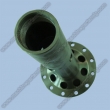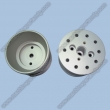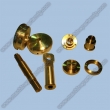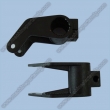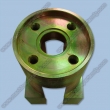CNC machining involves programming a series of movements through coordinates into a computer program and then allowing the machining tools to cut into a substrate according to the plotted path. It is an efficient system that allows for precise automated machining on large runs. Typical CNC machining originally ran on a 3-axis Cartesian system, with an x-, y-, and z-axis allowing for three-dimensional machining. However, with developments in machining technology and improvements in computing, additional axes were introduced to allow for even tighter machining for more intricate physical geometries.
3-axis into 5-axis
A typical 3-axis machining plot includes an x-, y- and z-axis, accounting for horizontal, vertical and depth movement. This array allows a CNC machine to be programmed according to three axes that encompass a fully three dimensional space. Programmers realized that additional axes could be created to allow the machine a better command of a given area. The five-axis CNC machine was developed to include rX-, rY- and rZ-axes, each of which represents a rotational plot around and parallel to the actual x-, y- and z-axes. These rotational axes allow the tool to tilt from side to side while moving. With these rotational spaces defined, a programmer can enter a much more intricate pattern for a machining tool to follow. Modern 5-axis machines can cut as close as 3 microns, for an almost perfect cut. Suddenly, applications requiring tighter tolerances were possible to machine with fully-automated equipment, a cut to both cost and labor.
With the advent of 5-axis machining, manufacturers could implement the new method in a variety of ways, leading to a diversity of 5-axis machines. There is typically no “standard” make up of 5-axis machines; in fact, many 5-axis CNC machines are designed with a specific application in mind.
Since the invention of 5-axis machining, developers have introduced additional axes to increase functionality, but for more basic automated needs 5-axis CNC machining parts remains one of the more common CNC arrays.
Using 5-Axes
With five axes of movement possible, the programming needs can look daunting, but there are many basic CAD/CAM programs that can make the process go smoothly. However, simple programming entries are not exclusive when using a 5-axis machine.
One major concern with 5-axis machining concerns the position of the substrate. Because of the degree of movement available with a 5-axis machine, the substrate should be relatively free in space. Many 5-axis machinists will suspend the substrate in order to achieve this physical freedom. When a substrate is relatively free in this manner, the tool has the freedom to move around and cut it from almost any angle, as designed. However, because a 5-axis CNC can operate with a number of different tools, this is not always necessary.
5-Axis Alternatives
Even though 5-axis CNC machining parts can provide a high level of freedom for tooling projects, it is not always the best choice for a job. Some jobs do not require the full level of axis rotation that 5-axis machining provides, while others require more. Simple jobs that can be performed by either a 3- or 5-axis CNC require thorough scrutiny to decide which of the two machines would be more cost effective to use in the process



